We may not have the course you’re looking for. If you enquire or give us a call on +91 8037244591 and speak to our training experts, we may still be able to help with your training requirements.
Training Outcomes Within Your Budget!
We ensure quality, budget-alignment, and timely delivery by our expert instructors.
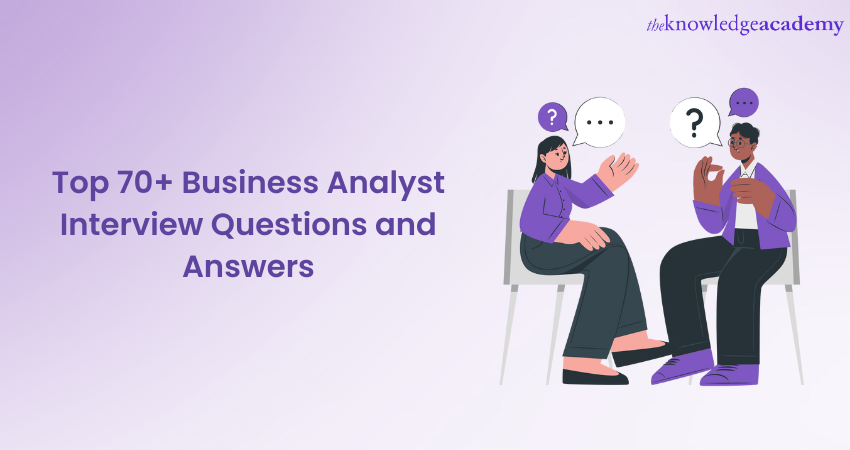
Candidates seeking to become successful Business Analysts often find themselves standing at crossroads when going for interviews, due to lack of preparation and confidence. However, they can eliminate the risk of being underconfident and nervous in front of hiring managers by preparing some Business Analyst Interview questions.
This blog provides you with an opportunity to showcase your problem-solving abilities, strategic thinking, adaptability, and effective communication skills. Ace your interview with 70+ essential Business Analyst Interview Questions commonly asked in every interview. So, read this blog for in-depth insights
Table of Contents
1) Business Analyst Interview Questions: Understanding the role
2) Core skills and competencies Interview Questions
3) Business Analyst Interview Questions: Technical and analytical abilities
4) Communication and interpersonal skills Interview Questions
5) Business Analyst Interview Questions: Experience and industry knowledge
6) Scenario-based questions
7) Business Analyst behavioural Interview Questions
8) Questions on Agile methodology
9) Questions on data analysis
10) Business Analyst Interview Questions on documentation and reporting
11) Questions on Stakeholder Management
12) Business Analyst Interview Questions on Project Management
13) Questions on requirements gathering and analysis
14) Conclusion
Business Analyst Interview Questions: Understanding the role
It is crucial to fully understand the role and duties of a Business Analyst before going into an interview for the position.Demonstrating a solid understanding of this role will highlight your suitability and expertise as a Business Analyst candidate. Here are some Business Analyst Interview Questions and answers relating to Business Analysis:
1) What is the role of a Business Analyst in an organisation?
A Business Analyst serves as a connector between business requirements and technology solutions. This role requires working closely with stakeholders to identify, analyse, and document project requirements. One of their vital responsibilities is to ensure that the end result aligns with the company's objectives and fulfils the requirements of all stakeholders involved.
2) How do you define the scope of a project as a Business Analyst?
As a Business Analyst, it’s essential to take on the responsibility of defining a project's scope. It involves identifying project goals, deliverables, boundaries, and constraints. As a Business Analyst, it’s crucial to collaborate with stakeholders to gather requirements, conduct thorough analysis, and clearly define the project's scope, setting the foundation for successful project execution.
3) What are the key deliverables of a Business Analyst during the project lifecycle?
Throughout the project lifecycle, a Business Analyst produces several key deliverables. These include functional and non-functional requirements documentation, use cases, process flows, data models, and impact assessments. Additionally, Business Analysts often contribute to testing and quality assurance activities, ensuring that the final solution meets the specified requirements.
4) How to ensure effective communication with stakeholders as a Business Analyst?
Effective communication is vital for a Business Analyst's success. To ensure clear and efficient communication with stakeholders, a Business Analyst should actively listen, ask relevant questions, and employ various communication techniques, such as workshops, meetings, and presentations. It is crucial to adapt communication styles to suit different stakeholders, ensuring that information is conveyed accurately and understood by all.
5) How to handle changes in requirements during a project as a Business Analyst?
Changes in requirements are a common occurrence during projects. As a Business Analyst, it’s essential to manage these changes effectively. This involves evaluating the impact of the change, considering its alignment with the project's objectives, and collaborating with stakeholders to assess the feasibility and implications of incorporating the change. Adapting documentation and communicating changes to the relevant parties are also vital aspects of managing requirement changes.
Core skills and competencies Interview Questions
As a Business Analyst, possessing the right set of skills and competencies is crucial for effectively fulfilling the responsibilities of the role. This section will focus on questions that assess the core Business Analyst Skills and competencies. . Let’s have a look at each one of them:
1) What are the key skills required to be an effective Business Analyst?
To be an effective Business Analyst, several key skills are essential. These comprise robust analytical and problem-solving capabilities, exceptional communication and interpersonal skills, critical thinking, meticulous attention to detail, and the aptitude to work harmoniously with cross-functional teams. Additionally, proficiency in requirements elicitation and documentation, data analysis, process modelling, and stakeholder management are highly valued skills.
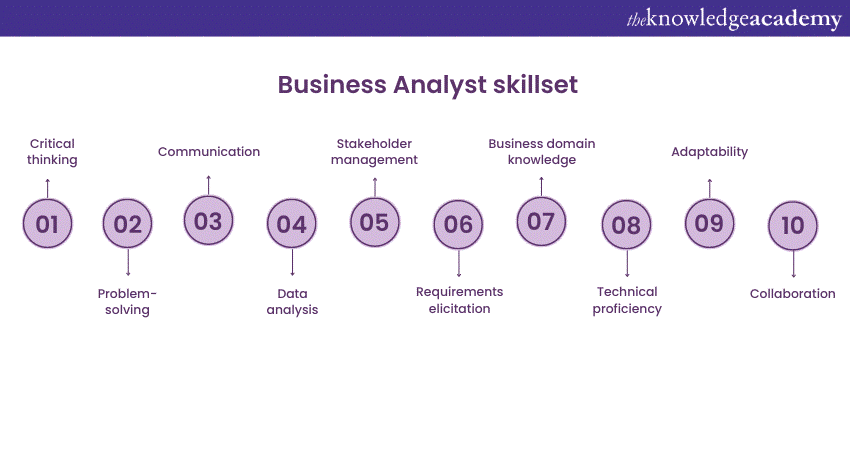
2) How do you prioritise requirements when faced with limited resources?
When faced with limited resources, prioritising requirements is crucial. As a Business Analyst, you should evaluate requirements based on their business value, alignment with project objectives, and potential impact on stakeholders. Techniques such as MoSCoW (Must have, Should have, Could have, Won't have) or cost-benefit analysis can be employed to prioritise requirements effectively. As a result, you canensure that the most critical and feasible ones are addressed first.
3) How do you ensure that stakeholders' expectations are met?
Meeting stakeholders' expectations is vital for project success. As a Business Analyst, you should actively engage with stakeholders to understand their needs, collaborate on requirement gathering, and communicate regularly to provide updates on progress. By maintaining open lines of communication, managing expectations, and seeking feedback throughout the project lifecycle, you can ensure that stakeholders' expectations are understood, managed, and ultimately met.
4) How do you manage contradictory requirements from various stakeholders?
Conflicting requirements from different stakeholders are not uncommon in projects. As a Business Analyst, it’s essential to navigate such situations diplomatically and find common ground. This involves attentively listening to all stakeholders, facilitating discussions to uncover the underlying reasons for conflicting requirements, and endeavouring to find compromises or alternative solutions that fulfil the needs of all parties involved.
5) Can you provide an example of a time when your analytical skills helped solve a complex problem?
Demonstrating your analytical skills through real-life examples is invaluable. Share a specific situation where you successfully employed your analytical skills to solve a complex problem as a Business Analyst. Explain the problem, the steps you took to analyse it, the techniques or tools you utilised, and the outcome achieved. This showcases your ability to think critically, apply analytical methods, and provide effective solutions.
6) How do you approach problem-solving as a Business Analyst?
Explain your problem-solving approach, highlighting your ability to gather information, analyse data, identify root causes, and propose effective solutions. Discuss any frameworks or methodologies you typically employ, such as SWOT analysis, root cause analysis, or the 5 Whys technique. Emphasise your ability to think critically, break down complex problems, and deliver practical and innovative solutions.
7) How do you manage your time and prioritise tasks as a Business Analyst?
Time management and task prioritisation are crucial for a Business Analyst's success. Describe your approach to managing your time effectively and prioritising tasks based on their urgency and impact. Discuss any tools or techniques you use, such as prioritisation matrices or project management software, to ensure that deadlines are met, and critical activities receive appropriate attention.
8) How do you ensure the accuracy and quality of your work as a Business Analyst?
Demonstrate your commitment to accuracy and quality in your work. Explain how you verify the integrity of your deliverables, such as requirements documentation or data analysis outputs. Discuss your attention to detail, your process for peer reviews or quality checks, and your dedication to ensuring that your work meets the highest standards.
Unleash the true potential of your business by mastering the art of Business Process Mapping with our transformative Business Process Mapping Training – join today!
Business Analyst Interview Questions: Technical and analytical abilities
Alongside the fundamental skills and competencies, having proficient technical and analytical abilities is crucial for a thriving career as a Business Analyst. This section will focus on questions that assess your technical expertise and analytical prowess. Let’s have a look at some Business Analyst Interview Questions and answers regarding technical and analytical abilities:
1) What software or tools to use for data analysis?
As a proficient Business Analyst, you should be familiar with a range of tools and software used for data analysis. Some commonly used tools include Microsoft Excel for data manipulation and analysis, SQL for querying databases, and data visualisation tools like Tableau or Power BI for presenting insights. Additionally, knowledge of statistical analysis tools like R or Python can be advantageous.
2) How do you identify and address gaps or inconsistencies in data?
As a Business Analyst, it's essential to possess techniques to identify and resolve gaps or inconsistencies in data. This can involve conducting data profiling and validation, performing data cleansing or transformation, and collaborating with relevant stakeholders to resolve any issues. Attention to detail and a systematic approach are crucial in identifying and rectifying data discrepancies.
3) Can you provide an example of a complex data analysis problem you have solved in the past?
Demonstrating your ability to tackle complex data analysis problems is highly valuable. You can share an example of a challenging data analysis problem you encountered in your previous role as a Business Analyst. Explain the problem, the approach you took to analyse the data, the methodologies or tools you employed, and the insights or solutions you derived from the analysis. This showcases your technical expertise and problem-solving skills in handling complex data scenarios.
4) How can you ensure data privacy and security when working with sensitive information?
Data privacy and security are critical considerations for a Business Analyst, especially when handling sensitive information. So, talk about the measures you take to ensure data security and privacy, such as adhering to relevant regulations (e.g., GDPR), implementing access controls, anonymising or pseudonymising data when necessary, and working closely with the organisation's IT and security teams to maintain data integrity and confidentiality.
5) What is Pareto Analysis?
Pareto Analysis, also known as the 80/20 rule, is a valuable decision-making technique for defect resolution and quality control. According to this rule, 20% of the causes are responsible for 80% of the effects in a system. This is why it is named the 80/20 rule.
6) Explain UML and its uses?
Unified Modelling Language (UML) is a general-purpose modelling language that provides a standard way to visualize a system's architecture, behaviour, and structure. It is used to identify and eliminate errors or bottlenecks in system performance.
7) What is BPMN and what are its basic elements?
BPMN, which stands for Business Process Model and Notation, is a widely accepted standard for representing business processes using graphical notations. The primary objective behind the creation of BPMN was to ensure that both business users and technical developers have a common understanding of how business processes work and to provide a simplified way to document and communicate these processes.
8) What do you understand by Gap Analysis, and what are the types of Gaps that can occur during an Analysis?
Gap Analysis is the process of identifying differences in functionality between existing and target systems. The identified differences are referred to as gaps and represent required changes to achieve desired results. Here are some common types of Gaps:
1) Profit Gap: The Profit Gap refers to the difference between the actual profit earned by a company and the profit that was estimated or expected.
2) Manpower Gap: A Manpower Gap is the difference between the actual workforce present and the needed workforce in a company.
3) Performance Gap: The Performance Gap refers to the difference between the expected and actual levels of performance.
4) Market Gap: The Market Gap refers to the difference between the estimated sales and the actual sales. It is a measure of the extent to which a product or service is over or under performing in the market.
9) What are the benefits of business process modelling?
Here are some key benefits of business process modelling:
1) Business process modelling provides a clear visual of each task to eliminate inefficiencies.
2) Business process modelling can highlight system flaws before they cause issues. By using visual models, you can easily identify potential slowdowns.
3) Business process modelling can help you turn your big ideas into reality. By using process modelling, your organisation can identify the specific steps needed to bring a plan to fruition, ensuring that it doesn't get lost in the shuffle.
Embrace the power of data-driven decision-making, demystify statistics, and gain a competitive edge with our Introduction to Statistics Course – join now!.
Communication and interpersonal skills Interview Questions
Effective communication and strong interpersonal skills are vital for a Business Analyst's success. Demonstrating proficiency in these areas will highlight your ability to build relationships, facilitate effective communication, and work harmoniously within cross-functional teams. Here are some Business Analyst Interview Questions relating to communication and interpersonal skills:
1) How do you efficiently convey technical information to stakeholders who don't have a technical background?
As a Business Analyst, you often need to convey technical information to stakeholders who may not have a technical background. Describe your approach to effectively communicating complex concepts or technical details in a clear and understandable manner. This may involve using plain language, visual aids, analogies, or real-life examples to bridge the gap between technical and non-technical stakeholders.
2) How do you handle conflicts or disagreements with stakeholders during a project?
Conflicts and disagreements with stakeholders can arise during projects. Share your approach to managing such situations. Emphasise your ability to actively listen, understand differing perspectives, and facilitate constructive discussions to reach a resolution. Highlight your skills in negotiation, diplomacy, and finding common ground to ensure that conflicts are addressed in a professional and collaborative manner.
3) Can you provide an example of a situation where you successfully facilitated collaboration between different teams?
Collaboration across teams is crucial for successful project outcomes. Illustrate a scenario where you facilitated collaboration between different teams as a Business Analyst. Explain the context, the teams involved, any challenges faced, and the strategies you employed to foster effective collaboration. Showcase your ability to bring diverse stakeholders together and create an environment of teamwork and synergy.
4) How do you ensure that all stakeholders are engaged, and their perspectives are considered?
To answer this question, describe your approach to stakeholder engagement, including techniques you use to gather their input, address their concerns, and keep them informed throughout the project lifecycle. Highlight your ability to build relationships, establish open lines of communication, and demonstrate empathy to ensure that stakeholders feel valued and involved.
5) Can you provide an example of a time when you faced resistance to change and how you addressed it?
Change management is a common challenge in projects. Share an example of a situation where you encountered resistance to change as a Business Analyst. Describe how you addressed the resistance, whether through stakeholder engagement, communication, training, or other change management techniques. Highlight your ability to navigate resistance, gain buy-in, and successfully implement changes.
6) How do you adapt your communication style to suit different stakeholders?
Adapting your communication style to suit different stakeholders is essential for effective communication. Discuss your ability to assess stakeholders' preferences, needs, and communication styles. Explain how you tailor your communication approach to match their preferences, whether it's using formal or informal language, adjusting the level of technical detail, or choosing appropriate communication channels. Emphasise your versatility in communication to foster effective engagement with stakeholders.
Master the art of effective communication, amplify your influence, and propel your success with our Communication Skills Training – register today!
Business Analyst Interview Questions: Experience and industry knowledge
Having relevant experience and industry knowledge can significantly enhance your effectiveness as a Business Analyst. Demonstrating your expertise and industry-specific knowledge will highlight your ability to contribute value and make informed decisions as a Business Analyst. Here are some Business Analyst Interview Questions and answers regarding experience and industry knowledge:
1) Can you describe a project where you successfully implemented process improvements?
Share an example of a project where you identified and implemented process improvements as a Business Analyst. Describe the context, the specific improvements made, and the outcomes achieved. Also, highlight your ability to analyse existing processes, identify inefficiencies, and propose effective solutions that resulted in enhanced productivity, cost savings, or improved customer satisfaction.
2) What do you consider the biggest challenges in the [specific industry] and how can a Business Analyst address them?
Illustrate your understanding of the unique obstacles encountered within the sector in which you function as a Business Analyst. Discuss the significant challenges and explain how a Business Analyst can contribute to addressing them. Showcase your understanding of industry trends, regulatory requirements, competitive landscape, and customer expectations. Emphasise your ability to identify opportunities for improvement and provide valuable insights to drive business success.
3) How do you stay updated with the latest trends and advancements in the Business Analyst field?
Continuous learning and staying abreast of industry advancements are essential for a Business Analyst. Describe the strategies you employ to stay updated with the latest trends and developments. This may include participating in professional development courses, attending industry conferences or webinars, reading industry publications and blogs, and engaging in knowledge-sharing communities. Demonstrate your commitment to professional growth and your ability to adapt to emerging practices and technologies.
4) Can you share an example of a project where you successfully managed stakeholders with diverse backgrounds and interests?
Managing stakeholders with diverse backgrounds and interests can be challenging. Provide an example of a project where you successfully handled such a situation. Discuss the diverse stakeholders involved, the potential conflicts or differing interests, and the strategies you employed to ensure effective stakeholder management. Showcase your ability to build relationships, foster collaboration, and find common ground among stakeholders with varying priorities.
5) How do you leverage your industry knowledge to inform your analysis and recommendations?
Explain how you use your industry knowledge to inform your analysis and recommendations as a Business Analyst. Discuss how your understanding of the industry landscape, market trends, and customer needs influences your approach to gathering requirements, conducting analysis, and making informed decisions. Showcase your ability to apply industry-specific insights to deliver valuable outcomes and solutions.
6) How do you stay updated with the latest trends and advancements in the field of data analysis and technology?
Keeping up with the rapidly evolving field of data analysis and technology is essential for a Business Analyst. Share your strategies for staying updated, such as participating in professional development courses, attending industry conferences or webinars, reading industry publications and blogs, and engaging with online communities or forums. This highlights your commitment to continuous learning and your proactive approach to staying abreast of emerging trends.
Embark on your journey to becoming a proficient business analyst, gain essential skills, and unlock endless career possibilities with our Business Analyst Fundamentals Course!
Scenario-based questions
Scenario-based questions are commonly used in Business Analyst interviews to assess your ability to apply your knowledge and skills to real-world situations. This section will present a set of scenario-based questions that require you to analyse, think critically, and propose solutions based on the given scenarios.
1) Scenario: You are working on a project with multiple stakeholders who have conflicting requirements. How would you approach this situation?
Your response should be as follows: In such a scenario, I would start by facilitating a collaborative discussion with all stakeholders to understand their perspectives and underlying needs. By actively listening and encouraging open dialogue, I would aim to find common ground and identify shared objectives. Through effective communication, negotiation, and a focus on the project's overarching goals, I would work towards reconciling conflicting requirements and seeking win-win solutions that satisfy the majority of stakeholders.
2) Scenario: You have identified a process bottleneck that is hindering efficiency and productivity. How would you address this issue?
Your response should be as follows: To address a process bottleneck, I would conduct a thorough analysis to understand the root cause and impact on the overall process. I would collaborate with relevant stakeholders, including process owners and subject matter experts, to gather insights and potential solutions. By applying process improvement methodologies like Lean or Six Sigma, I would identify opportunities to streamline the process, eliminate waste, and improve efficiency. Implementing these improvements in a phased manner, while closely monitoring the impact, would help address the bottleneck and enhance productivity.
3) Scenario: You have been assigned to gather requirements for a software development project with a tight deadline. However, some key stakeholders are unavailable for meetings or are unresponsive. How would you handle this situation?
Your response should be as follows: In this scenario, I would employ several strategies to ensure the gathering of requirements despite the availability challenges. Firstly, I would proactively communicate with the stakeholders, emphasising the importance of their input and the impact of their availability on the project's success. I would explore alternative means of gathering requirements, such as conducting one-on-one interviews or virtual collaboration sessions. Additionally, I would prioritise requirements gathering with the available stakeholders and work towards bridging the communication gap with the unresponsive ones. Regular follow-ups, clear documentation, and leveraging the expertise of proxy stakeholders would be key to ensuring that crucial requirements are captured within the given timeframe.
4) Scenario: You have been assigned to work on a cross-functional team consisting of members from different departments with conflicting work styles and priorities. How would you foster collaboration and ensure effective teamwork?
Your response should be as follows: In this scenario, I would focus on building strong relationships and fostering collaboration among team members. I would organise team-building activities or workshops to establish trust and understanding among the members. Clear communication channels and regular project status meetings would facilitate ongoing collaboration. By acknowledging and respecting the diverse work styles and priorities, I would encourage open dialogue, active listening, and consensus-building to align the team towards a shared goal. Additionally, I would emphasise the value each team member brings and encourage recognition of individual contributions to foster a positive and inclusive team environment.
5) Scenario: You have been assigned to work on a project where the requirements are constantly changing due to evolving business needs. How would you manage these changing requirements effectively?
Your response should be as follows: Managing changing requirements requires a flexible and adaptive approach. I would establish a robust change management process, including formalising a change request procedure and documentation. I would closely collaborate with stakeholders to understand the rationale behind the changing requirements and assess their impact on project objectives. Through impact analysis and prioritisation exercises, I would evaluate the feasibility and implications of incorporating the changes. Clear communication with all stakeholders, including regular updates on requirement changes and their consequences, would ensure transparency and facilitate effective decision-making throughout the project.
Business Analyst behavioural Interview Questions
Behavioural questions are designed to assess your past experiences and behaviours to gain insights into how you approach challenges, collaborate with others, and handle various situations.
1) Can you recall a situation where you had to convince a reluctant stakeholder to embrace a suggested solution? How did you handle the circumstance and what was the result?
Your response should be as follows: In a previous project, I encountered a stakeholder who was resistant to adopting a new software solution due to concerns about its impact on existing processes. To address this, I scheduled a meeting with the stakeholder to understand their concerns and perspectives. I actively listened, empathised with their reservations, and addressed their specific objections. I presented a well-researched business case that highlighted the benefits of the proposed solution, such as improved efficiency and cost savings. Through open and transparent communication, I managed to gain their trust and secure their buy-in. As a result, the stakeholder not only accepted the solution but also became an advocate for its successful implementation.
2) Can you provide an instance where you had to collaborate with a difficult team member? How did you handle the situation and what was the result?
Your response should be as follows: In a cross-functional project, I encountered a team member who consistently exhibited challenging behaviour, often resisting collaboration and imposing their own ideas. To address this, I proactively sought to understand their perspective and motivations. I engaged in one-on-one discussions, actively listened to their concerns, and acknowledged their expertise. I fostered an environment of open communication and encouraged the sharing of ideas. By leveraging their strengths and involving them in decision-making processes, I gradually gained their trust and cooperation. Eventually, the team member became more receptive, and we were able to work collaboratively, resulting in improved team dynamics and project outcomes.
Elevate your business analysis skills, unlock new career opportunities, and thrive in the dynamic world of business with our comprehensive Business Analyst Training – join now!
3) Describe a situation where you had to handle conflicting priorities and tight deadlines. How did you manage the situation and ensure successful project completion?
Your response should be as follows: In a fast-paced project, conflicting priorities and tight deadlines were a constant challenge. To manage this situation, I first assessed the criticality and urgency of each task or requirement. I prioritised them based on impact and alignment with project objectives. I communicated the revised timeline and expectations to stakeholders, ensuring transparency and managing their expectations. I collaborated with team members to delegate tasks efficiently, leveraging their strengths and expertise. By employing effective time management techniques, such as setting milestones and monitoring progress, I was able to ensure timely completion of deliverables and successful project outcomes.
4) Share an example of a time when you faced unexpected obstacles during a project. How did you adapt and overcome these challenges?
Your response should be as follows: During a complex project, unforeseen obstacles arose that threatened project timelines. To address these challenges, I quickly assessed the impact of the obstacles and sought input from relevant stakeholders. I engaged in problem-solving sessions, encouraging creative thinking and collaboration. By adapting project plans and resource allocation, I mitigated the impact of the obstacles. I communicated transparently with the project team and stakeholders, ensuring everyone was aware of the changes and the rationale behind them. Through effective contingency planning and agile decision-making, I successfully navigated the obstacles and achieved project milestones.
5) Describe a situation where you received constructive feedback on your work. How did you respond and what did you learn from the experience?
Your response should be as follows: I received constructive feedback on a requirements document I had prepared. Initially, I felt defensive, but I realised the value of the feedback in improving my work. I thanked the person for their input and took time to reflect on their suggestions. I analysed their comments, identified areas for improvement, and made the necessary revisions to the document. I sought clarification on certain points to ensure a thorough understanding of the feedback. Ultimately, I recognised that feedback is an opportunity for growth and learning. This experience reinforced the importance of open-mindedness, continuous improvement, and the value of incorporating feedback to deliver high-quality work.
Level up your business analysis skills, become a master of problem-solving with our Business Analyst Black Belt Course.
Questions on Agile methodology
Agile methodology has gained popularity in Project Management, and Business Analysts frequently operate within Agile frameworks. This section will focus on questions that assess your understanding of Agile methodology and how you apply Agile principles in your work as a Business Analyst. So, let’s have a look at some Agile Business Analysts Interview Questions:
1) What is Agile methodology, and how does it differ from traditional project management approaches?
Explain the key principles of Agile methodology, such as iterative development, self-organising teams, and frequent collaboration with stakeholders. Highlight the differences between Agile and traditional waterfall approaches, emphasising the iterative nature of Agile, adaptability to change, and the focus on delivering incremental value throughout the project.
2) How do you ensure effective collaboration and communication in an Agile team?
Describe your approach to fostering collaboration and communication in an Agile team. Discuss techniques such as Daily Stand-up Meetings, Sprint Planning Sessions, and frequent feedback loops. Highlighting the significance of cross-functional collaboration, regular stakeholder engagement, and maintaining transparent communication channels is crucial to foster a shared comprehension of project objectives and requirements.
3) How do you prioritise requirements within an Agile framework?
Explain how you prioritise requirements in an Agile project. Discuss techniques like the MoSCoW method (Must have, Should have, Could have, Won't have), story mapping, or user story prioritisation. Highlight the importance of involving stakeholders in the prioritisation process and considering business value, customer needs, and project objectives when determining the order in which requirements are addressed.
4) How do you handle changes in requirements during an Agile project?
Changes in requirements are common in Agile projects. Describe your approach to managing changing requirements. Discuss techniques like backlog refinement, user story re-estimation, and stakeholder engagement. Emphasise the importance of collaboration with the product owner and stakeholders to assess the impact of changes, determine their priority, and make informed decisions on incorporating them into the project scope.
5) How do you measure project progress and success in an Agile environment?
Explain how you measure project progress and success in an Agile environment. Discuss the use of Agile metrics such as velocity, burndown charts, or cumulative flow diagrams. Highlight the importance of frequent iterations, continuous feedback, and the delivery of working increments to demonstrate progress. Emphasise the focus on delivering value to stakeholders and achieving customer satisfaction as indicators of project success.
6) What does INVEST stand for?
INVEST stands for Independent, Negotiable, Valuable, Estimable, Sized appropriately, and Testable. Business Analysts and Project Managers use this term to deliver quality services and products.
Embrace the agility, drive innovation, and excel in Business Analysis with our comprehensive Agile Business Analysis Training – register today.
Questions on data analysis
Data analysis is a critical aspect of a Business Analyst's role. This section will focus on questions that assess your knowledge and skills in data analysis, including techniques, tools, and best practices. Let's look at these questions in greater detail:
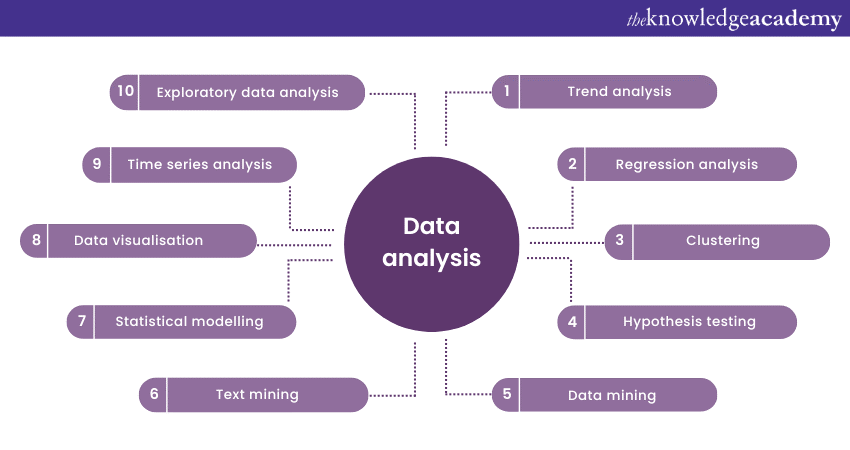
1) What are the key steps you follow when conducting data analysis?
Describe your approach to data analysis, highlighting the key steps you follow. This may include data collection, data cleaning and preprocessing, exploratory data analysis, applying statistical techniques, deriving insights, and presenting findings. Emphasise your ability to apply a systematic and structured approach to ensure accurate and meaningful data analysis.
2) How do you determine which data analysis techniques to use for a specific project?
Explain how you determine which data analysis techniques are most appropriate for a given project. Discuss the importance of understanding project objectives, available data, and stakeholder requirements. Highlight your ability to assess different techniques, such as regression analysis, clustering, or trend analysis, and select the most suitable technique based on the specific project context and desired outcomes.
3) Can you provide an example of a time when you used data analysis to identify trends or patterns that led to valuable insights?
Share an example where you utilised data analysis to uncover trends or patterns that provided valuable insights. Describe the problem or question you were addressing, the data analysis techniques you applied, and the insights or recommendations you derived from the analysis. Emphasise the impact of your findings and how they influenced decision-making or improved business outcomes.
4) How do you ensure data accuracy and integrity during the data analysis process?
You can explain the measures you take to ensure data accuracy and integrity throughout the process. Discuss techniques like data validation, data cleansing, outlier detection, and cross-referencing with other trusted sources. Highlight the importance of documenting data sources, transformations applied, and any assumptions made to maintain transparency and ensure the reliability of your analysis.
5) How do you communicate data analysis findings to stakeholders effectively?
Effective communication of data analysis findings is essential. Describe your approach to presenting data analysis results to stakeholders. Discuss techniques like data visualisation, storytelling with data, and clear and concise reporting. Emphasise your ability to tailor the presentation of findings to the target audience, ensuring that the insights are easily understood and actionable.
Develop your prowess in data analysis, unlock valuable insights, and deliver impactful presentations with our comprehensive Data Analysis Skills Training.
Business Analyst Interview Questions on documentation and reporting
Effective documentation and reporting are crucial aspects of a Business Analyst's role. This section will focus on questions that assess your ability to create comprehensive and clear documentation, as well as communicate findings and recommendations through reports. Let’s have a look at it:
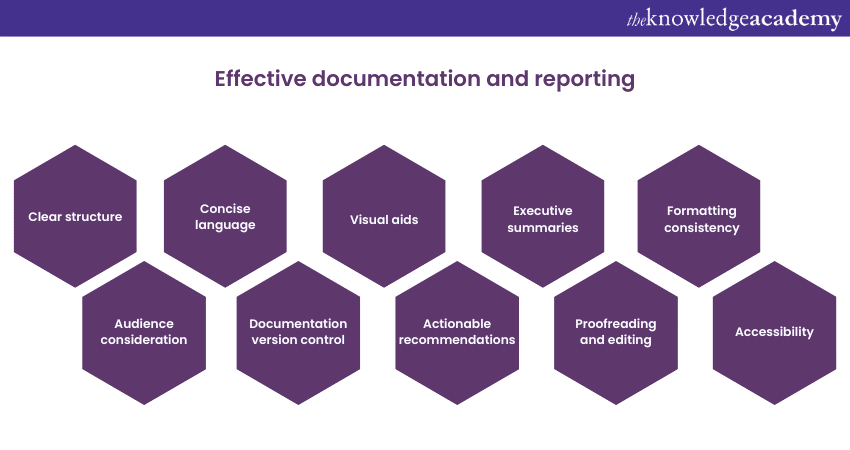
1) How do you ensure that your documentation is thorough and accurate?
Explain your approach to creating thorough and accurate documentation. Discuss techniques like conducting detailed requirements gathering, verifying information with stakeholders, and employing a systematic and structured documentation process. Highlight the importance of clear and concise language, proper formatting, and regular reviews to ensure the accuracy and completeness of your documentation.
2) How do you tailor your documentation for different audiences?
Effective communication requires tailoring documentation to suit the needs of different audiences. Describe your approach to tailoring your documentation for various stakeholders, such as technical teams, management, or end-users. Discuss techniques like adapting language and terminology, emphasising relevant details, and presenting information in a format that is easily understandable and actionable for the specific audience.
3) Can you provide an example of a complex document you created that effectively conveyed complex information?
Share an example of a complex document you created that effectively conveyed complex information. Describe the purpose of the document, the complex information it contained, and the techniques you employed to make the content clear and accessible. Highlight any visual aids, diagrams, or structured sections that helped simplify the information and improve understanding for the intended audience.
4) How do you ensure that your reports effectively communicate findings and recommendations?
Explain your approach to creating reports that effectively communicate findings and recommendations. Discuss the structure of your reports, including executive summaries, clear headings, and logical flow. Emphasise your ability to distil complex information into key insights, use visualisations to support your findings, and provide actionable recommendations that align with the project objectives.
5) How do you ensure that your documentation and reports are easily maintainable and updatable?
Maintainability and updatability are crucial aspects of documentation and reporting. Describe your strategies for creating documentation and reports that can be easily maintained and updated. Discuss the use of templates, version control, and clear documentation conventions. Highlight your attention to detail, organisation, and the documentation of assumptions and dependencies to facilitate future updates and revisions.
6) What is SRS and what are its key elements?
A System Requirements Specification (SRS) or a Software Requirements Specification is a document or a set of documents that outlines the features of a system or software application. The document(s) comprises various components that define the intended functionality needed by the stakeholders and customers to meet the needs of end-users.
Take your first step towards becoming a proficient business analyst, develop essential skills, and earn your Business Analyst Green Belt Course!
Questions on Stakeholder Management
Effective Stakeholder Management is essential for a Business Analyst's success. This section will focus on questions that assess your ability to identify, engage, and manage stakeholders throughout the project lifecycle. So, let’s have a detailed look at these questions:
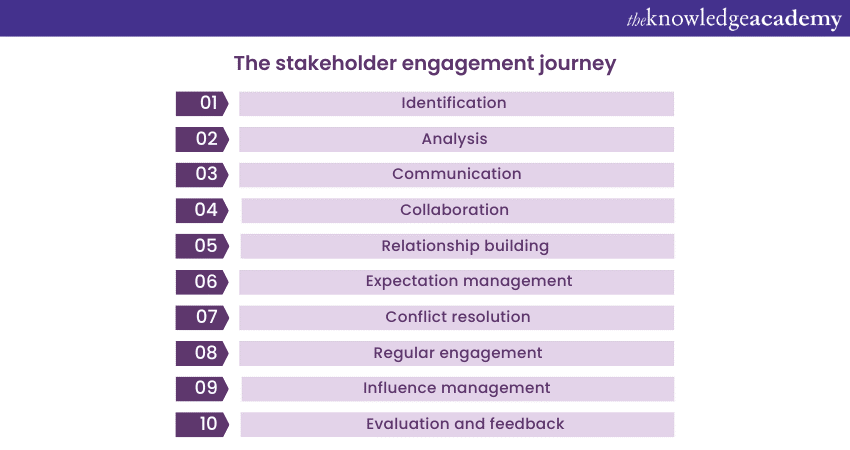
1) How do you identify and prioritise stakeholders in a project?
Explain your approach to identifying and prioritising stakeholders. Discuss techniques such as stakeholder analysis, mapping, or interviews to identify individuals or groups with a vested interest in the project. Emphasise the importance of considering their influence, impact, and level of involvement to prioritise stakeholders effectively
2) How do you engage and involve stakeholders in the requirements gathering process?
Describe your strategies for engaging stakeholders in the requirements gathering process. Discuss techniques such as workshops, interviews, or surveys to gather their input and perspectives. Highlight your ability to facilitate effective communication, actively listen to stakeholders, and create an inclusive and collaborative environment that encourages their active participation.
3) How do you ensure ongoing stakeholder communication and involvement throughout the project?
Explain your approach to ensuring ongoing stakeholder communication and involvement. Discuss techniques such as regular status meetings, progress updates, or stakeholder feedback sessions. Emphasise your ability to tailor communication methods and frequency to suit stakeholders' preferences, maintaining transparency, and keeping them informed and engaged throughout the project lifecycle.
4) How do you handle conflicting stakeholder interests or priorities?
Conflicting stakeholder interests or priorities are common in projects. Describe your approach to managing such conflicts. Discuss techniques such as active listening, facilitating discussions, or negotiation to find common ground. Highlight your ability to analyse the impact and implications of conflicting interests, facilitate compromise, and work towards solutions that satisfy the majority of stakeholders.
Forge powerful connections, amplify collaboration, and ignite remarkable project outcomes with our Creating Effective Stakeholder Engagement Training – join today!
Business Analyst Interview Questions on Project Management
Having Project Management skills is essential for a Business Analyst's role. This section will focus on questions that assess your understanding of Project Management principles, your ability to coordinate and oversee projects, and your knowledge of Project Management tools and techniques. So, let’s have a look at these Project Management questions that are important for Business Analysts to know:
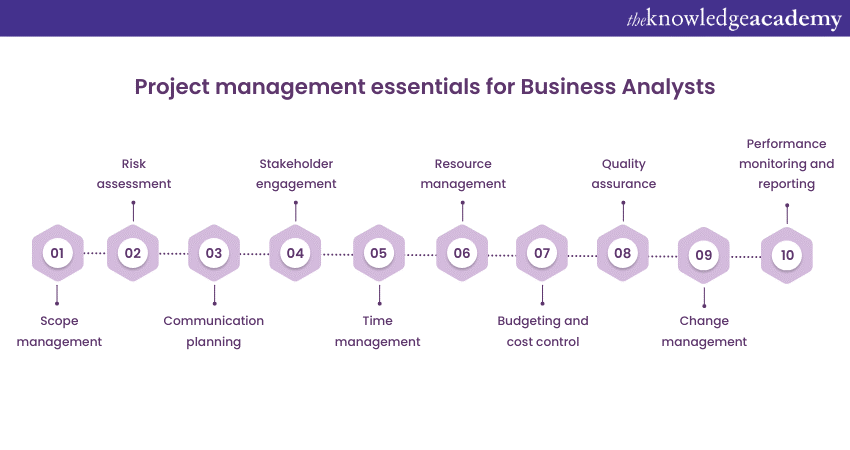
1) How do you define project scope and ensure its alignment with project objectives?
Explain your approach to defining project scope and ensuring it aligns with project objectives. Discuss techniques such as requirements gathering, stakeholder analysis, and scope documentation. Highlight your ability to identify project boundaries, manage scope changes, and ensure that project deliverables are aligned with the desired outcomes.
2) How do you identify and manage project risks?
Describe your approach to identifying and managing project risks. Discuss techniques such as risk identification workshops, risk registers, and risk mitigation strategies. Emphasise your ability to assess the potential impact and likelihood of risks, develop contingency plans, and monitor and mitigate risks throughout the project lifecycle.
3) Can you provide an example of a project you successfully managed from initiation to completion?
Share an example of a project you managed from initiation to completion. Describe the project's objectives, scope, timeline, and key deliverables. Explain how you organised and coordinated project activities, managed resources, and ensured the project was delivered within budget and on schedule. Highlight any challenges you faced and the strategies you employed to overcome them.
4) How do you ensure effective communication and collaboration within project teams?
Explain your approach to ensuring effective communication and collaboration within project teams. Discuss techniques such as regular team meetings, clear roles and responsibilities, and collaborative tools. Emphasise your ability to foster a positive team culture, facilitate knowledge sharing, and encourage open communication to enhance team collaboration and performance.
5) How do you monitor and report project progress to stakeholders?
Describe your strategies for monitoring and reporting project progress to stakeholders. Discuss techniques such as progress tracking, milestone reviews, and status reporting. Highlight your ability to provide timely and accurate project updates, communicate any deviations from the plan, and present progress in a clear and concise manner to keep stakeholders informed and engaged.
Equip yourself with the essential tools and strategies, elevate your Project Management skills, and achieve project success with our Project Management Courses.
6) What is process design?
Process design is a methodology that businesses use to analyse industry challenges and find effective solutions. Workflows are created to achieve the best outcome in the shortest amount of time.
Questions on requirements gathering and analysis
Requirements gathering and analysis are vital skills for a Business Analyst. This section will focus on questions that assess your ability to elicit, document, and analyse requirements to ensure successful project delivery.
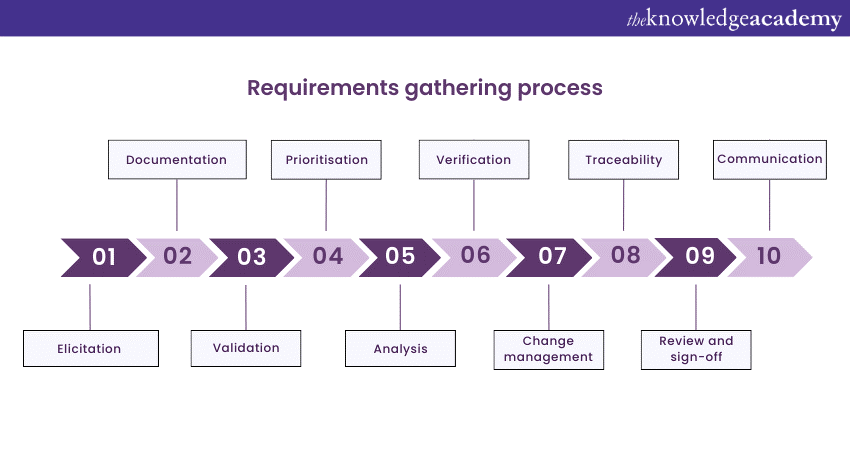
1) How do you elicit requirements from stakeholders?
Explain your approach to eliciting requirements from stakeholders. Discuss techniques such as interviews, workshops, and observation to gather information and gain a deep understanding of stakeholder needs. Highlight your ability to ask probing questions, actively listen, and employ effective requirements gathering techniques to elicit comprehensive and accurate requirements.
2) How do you ensure that requirements are complete, clear, and aligned with project objectives?
Describe your strategies for ensuring that requirements are complete, clear, and aligned with project objectives. Discuss techniques such as requirements prioritisation, traceability matrix, and validation with stakeholders. Emphasise your ability to conduct thorough requirements reviews, refine and clarify requirements, and align them with the project goals to ensure successful project delivery.
3) Can you provide an example of a challenging requirement you successfully elicited and resolved?
Share an example of a challenging requirement you encountered and successfully resolved. Describe the specific requirement, the challenges faced in eliciting and clarifying it, and the strategies you employed to resolve any ambiguities. Highlight your ability to collaborate with stakeholders, seek clarification, and employ problem-solving techniques to ensure a clear and actionable requirement.
4) How do you handle conflicting or changing requirements during a project?
Conflicting or changing requirements are common in projects. Describe your approach to managing such situations. Discuss techniques such as requirements prioritisation, impact analysis, and stakeholder engagement. Highlight your ability to facilitate discussions, negotiate trade-offs, and manage changes to requirements while considering the impact on project scope, timeline, and resources.
5) How do you ensure that the documented requirements are understandable and accessible to all stakeholders?
Explain your strategies for ensuring that the documented requirements are understandable and accessible to all stakeholders. Discuss techniques such as creating user-friendly documentation, using visual aids, and conducting requirements walkthroughs. Emphasise your ability to communicate requirements clearly, tailor the documentation for different audiences, and ensure that stakeholders have a shared understanding of the requirements.
What is the purpose of the Requirement Traceability Matrix?
The Requirements Traceability Matrix (RTM) is a document that plays a crucial role in the verification process of a system. It ensures that all requirements defined for the system are linked and tested with respect to test parameters and protocols. The RTM guarantees that no requirement is missed during the verification process and that all of them are duly tested.
List the elicitation techniques in Business Analytics.
Elicitation is the practice of gathering requirements from customers and stakeholders. There are various
Frequently Asked Questions
Upcoming Career Growth Batches & Dates
Date
 Certified Business Analyst Professional (CBA-PRO)
Certified Business Analyst Professional (CBA-PRO)
Thu 6th Jun 2024
Thu 10th Oct 2024
Thu 19th Dec 2024









 Top Rated Course
Top Rated Course

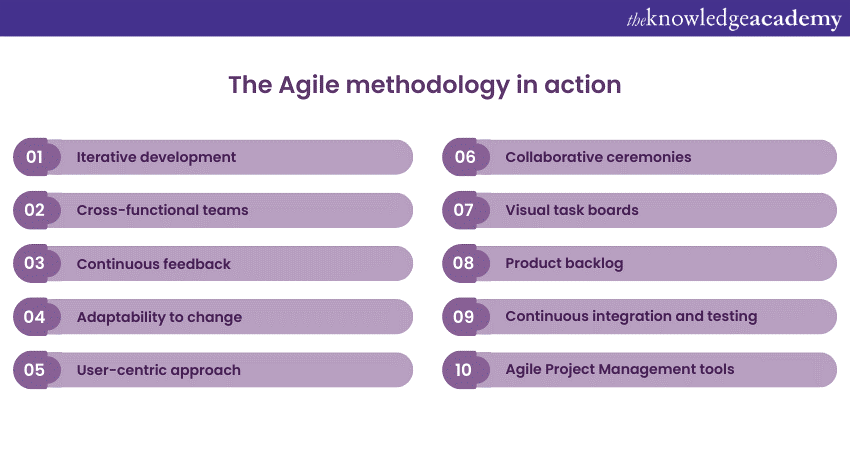



 If you wish to make any changes to your course, please
If you wish to make any changes to your course, please


